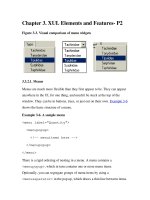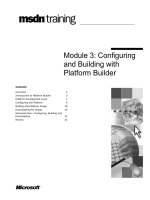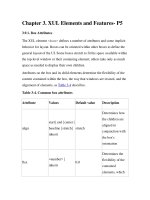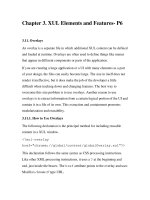Module 3 creating groups and organizational units
Bạn đang xem bản rút gọn của tài liệu. Xem và tải ngay bản đầy đủ của tài liệu tại đây (756.07 KB, 27 trang )
Module 3
Creating Groups and
Organizational Units
Module Overview
• Introduction to Groups
• Managing Groups
• Creating Organizational Units
Lesson 1: Introduction to Groups
• What Are Groups?
• AD DS Domain Functional Levels
• What Are Global Groups?
• What Are Universal Groups?
• What Are Domain Local Groups?
• What Are Local Groups?
• Discussion: Identifying Group Usage
• What Is Group Nesting?
• Discussion: Strategies for Nesting AD DS Groups
What Are Groups?
Groups are a logical collection of similar objects:
• Users
• Computers
• Other Groups
There are two types of groups:
Security groups
Can be used to assign permissions and rights
Can also be e-mail-enabled with Exchange Server
Distribution groups
Cannot be used to assign permissions
Used for e-mail distribution lists
AD DS Domain Functional Levels
Domain Functional Level
Available in Windows
Server 2008
Supported Domain Controller
Operating System
Windows 2000
Windows® 2000 Native
Windows Server 2003
Windows Server 2008
Windows Server® 2003
Windows Server 2008
Windows Server 2003
Windows Server 2008
Windows Server 2008
Domain Functional Levels that are available in Windows
Server 2003:
•Windows Server 2003 Interim
•Windows 2000 Mixed
•Windows Server 2003
•Windows 2000 Native
What Are Global Groups?
Members:
•
User and Computer accounts from the same
domain as the global group
•
Global groups from the same domain as the global group
Permissions:
•
Global groups can be assigned permissions in any domain in
the forest or any trusting domain
Usage:
•
Manage directory objects that require daily maintenance, such
as user and computer accounts
•
Group users who have similar network access requirements
Can be converted to:
•
Universal (if it is not a member of any other global groups)
What Are Universal Groups?
Members:
•
Global groups from any domain in the forest
•
User and Computer accounts from any domain
in the forest
•
Universal groups from any domain in the forest
Permissions:
•
Can be assigned permissions in any domain in the forest or any
trusting domain
Usage:
•
Use to combine groups that span domains
Can be converted to:
•
Domain local
•
Global (if no other universal groups exist as members)
What Are Domain Local Groups?
Members:
•
Accounts from any domain in the forest or
any trusted domain
•
Global groups from any domain in the forest or
any trusted domain
•
Universal groups from any domain in the forest or any trusted domain
Domain local groups, but only from the same domain as the domain
local group
•
Usage:
•
Use to define and manage access to resources in a single domain
Permissions:
•
Member permissions can be assigned only within the same domain as
the domain local group
Can be converted to:
•
Universal (if no other domain local groups exist as members)
What Are Local Groups?
Members:
•
Local users
•
Domain users
•
Domain groups
Permissions:
•
Local groups can be assigned permissions on the local
computer only
Local groups cannot be created on domain controllers
Discussion: Identifying Group Usage
For each scenario, determine the type and scope of groups that
must be created:
Scenario 1: A. Datum has HR users spread throughout the domain in
several different geographic locations, but require access to the same
resources.
Scenario 2: Tailspin Toys has two domains, one for the United States
and one for Europe. You want to create a group that enables the
centralized help desk to manage resources in both domains.
Scenario 3: A. Datum has users in Sales that are geographically
dispersed. They have requested a single unified group that will allow
for all Sales users to access resources. Membership of the Sales
group frequently changes.
Scenario 4: Trey Research has a single domain. They want to create
groups for the users in Sales, IT and Research departments so they
can easily send e-mails to these groups instead of the individual
users.
What Is Group Nesting?
Nesting allows for groups to be
members of other groups
Benefits of using a nesting strategy in managing AD DS
groups:
Groups that are members of other groups reduce
replication
Nested groups provide for simplified management
Discussion: Strategies for Nesting AD DS Groups
• Scenario 1: A. Datum has HR users are spread throughout the
domain in several different geographic locations, but require
access to the same resources. How can nested groups be used
to simplify management?
• Scenario 2: Tailspin Toys has two domains, the United States
and Europe. You want to create a group for the centralized Help
Desk to manage resources in both domains and reduce the
replication traffic between the domains.
• Scenario 3: At A. Datum, you have to assign permissions to a
folder on a member server for a project between Sales,
Marketing, and Finance. All users are geographically dispersed.
How would you use nesting groups in this scenario?
• Scenario 4: Trey Research wants to give the HR department
permissions to a file share. The user GSmith needs to be added
to the HR group. How would you use AGDLP in the scenario?
Lesson 2: Managing Groups
• Considerations for Naming Groups
• Identifying Group Membership
Considerations for Naming Groups
Use concise naming
• Avoid long complicated names
• Use common names
• Sales
Use departmental names
• Marketing
• Executives
Group users to locations:
Use geographic names
Countries
States
Cities
Use project specific names If virtual teams are created for a project,
use the project name as a descriptor
Names should be specific enough to accurately describe their purpose,
but not so specific that there is a group for every subfunction
Demonstration: Creating Groups
In this demonstration, you will see how to:
• Create groups with Active Directory Users and Computers
• Create a group using dsadd
• Add members to a group
• Use the Managed By tab to delegate administration
Identifying Group Membership
Members tab
Members of a group are
listed in the Members
tab:
•Individual Users
•Nested Groups
Members Of tab
The Members Of tab
lists the groups to which
the current group
belongs
You can use either tab to track group membership
Demonstration: Modifying Group Scope and Type
In this demonstration, you will see how to:
• Modify group scope and type
Lesson 3: Creating Organizational Units
• What Is an Organizational Unit (OU)?
• What Is an OU Hierarchy?
• OU Hierarchy Examples
• OUs and Groups Summary
What Is an Organizational Unit (OU)?
An organizational unit (OU):
• Is a directory object within the domain
• Is the smallest scope or unit to which you
can assign Group Policy settings or delegate administrative
authority
• Can contain users, computers, groups, printers, and
other OUs
OUs are used to:
Create administrative boundaries within the domain by
delegating authority
Create containers within the domain model to represent
logical structures
Enforce Group Policy
What Is an OU Hierarchy?
OUs can be put inside other OUs to create a hierarchical design
WoodgroveBank.com
Builtin
Business Units
Business Management
Delegation
Product Development
Accounts
Delegation
Resources
Security Groups
OU Hierarchy Examples
Example
Benefit
Geographic OUs
• Can be administered at the location level
Departmental OUs
• Delegation by job function
Resource OUs
By management
• Designed to manage resource (nonuser)
objects
• Build OUs around the administration of
the business
Demonstration: Creating OUs
In this demonstration, you will see how to:
• Create an OU
• Move objects between OUs
• Create an OU using dsadd
• Delegate control over an OU
OUs and Groups Summary
OUs
Groups
You can apply group policy settings You cannot apply group policy
to an OU
settings directly to a group
One user can belong to one OU at a One user can belong to multiple
time
groups at a time
You can’t use an OU to grant or
deny security access permissions
to resources
Groups are used to grant or deny
security access permissions to
resources
You can’t use an OU to distribute e- You can use groups to distribute email
Lab: Creating an OU Infrastructure
• Exercise 1: Creating AD DS Groups
• Exercise 2: Planning an OU Hierarchy (Discussion)
• Exercise 3: Creating an OU Hierarchy
Logon information
Virtual machine
NYC-DC1, NYC-SVR1
User name
Administrator
Password
Pa$$w0rd
Estimated time: 45 minutes
Lab Scenario
• Woodgrove Bank is an enterprise that has offices located
in several cities throughout the world. Woodgrove Bank is
opening a new subsidiary in Vancouver, and they need an
OU design for the subsidiary. Woodgrove Bank has
deployed AD DS on servers running Windows Server 2008,
and one of your primary tasks will be to create a new OU
design and move users from current positions to the new
subsidiary.









